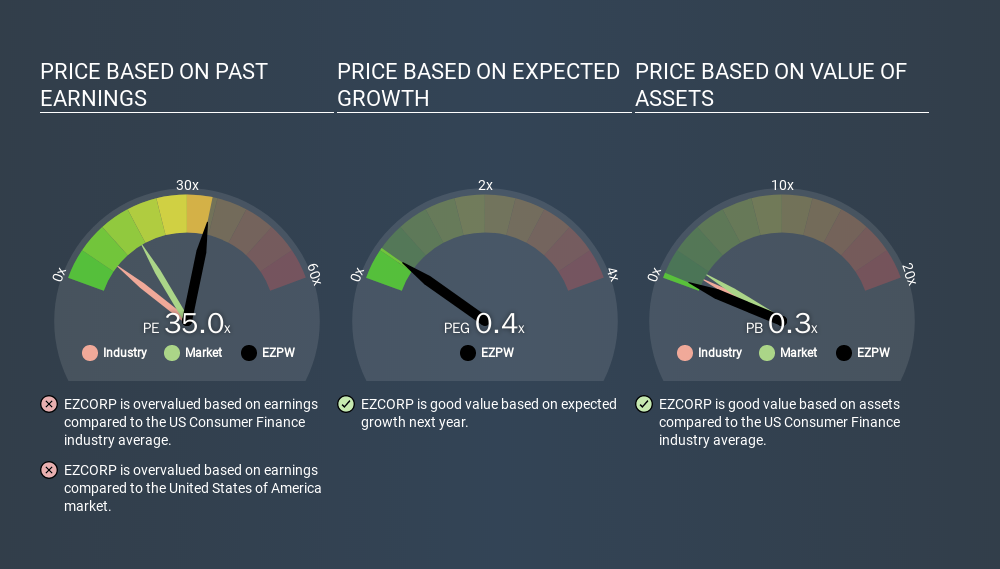- United States
- /
- Consumer Finance
- /
- NasdaqGS:EZPW
A Sliding Share Price Has Us Looking At EZCORP, Inc.'s (NASDAQ:EZPW) P/E Ratio
Unfortunately for some shareholders, the EZCORP (NASDAQ:EZPW) share price has dived 30% in the last thirty days. That drop has capped off a tough year for shareholders, with the share price down 51% in that time.
All else being equal, a share price drop should make a stock more attractive to potential investors. In the long term, share prices tend to follow earnings per share, but in the short term prices bounce around in response to short term factors (which are not always obvious). The implication here is that long term investors have an opportunity when expectations of a company are too low. Perhaps the simplest way to get a read on investors' expectations of a business is to look at its Price to Earnings Ratio (PE Ratio). A high P/E implies that investors have high expectations of what a company can achieve compared to a company with a low P/E ratio.
See our latest analysis for EZCORP
How Does EZCORP's P/E Ratio Compare To Its Peers?
We can tell from its P/E ratio of 35.03 that there is some investor optimism about EZCORP. You can see in the image below that the average P/E (7.8) for companies in the consumer finance industry is a lot lower than EZCORP's P/E.

Its relatively high P/E ratio indicates that EZCORP shareholders think it will perform better than other companies in its industry classification. The market is optimistic about the future, but that doesn't guarantee future growth. So further research is always essential. I often monitor director buying and selling.
How Growth Rates Impact P/E Ratios
P/E ratios primarily reflect market expectations around earnings growth rates. When earnings grow, the 'E' increases, over time. And in that case, the P/E ratio itself will drop rather quickly. Then, a lower P/E should attract more buyers, pushing the share price up.
EZCORP saw earnings per share decrease by 67% last year. But over the longer term (3 years), earnings per share have increased by 36%.
A Limitation: P/E Ratios Ignore Debt and Cash In The Bank
It's important to note that the P/E ratio considers the market capitalization, not the enterprise value. Thus, the metric does not reflect cash or debt held by the company. Hypothetically, a company could reduce its future P/E ratio by spending its cash (or taking on debt) to achieve higher earnings.
Such expenditure might be good or bad, in the long term, but the point here is that the balance sheet is not reflected by this ratio.
How Does EZCORP's Debt Impact Its P/E Ratio?
EZCORP has net debt equal to 37% of its market cap. While that's enough to warrant consideration, it doesn't really concern us.
The Bottom Line On EZCORP's P/E Ratio
EZCORP has a P/E of 35.0. That's higher than the average in its market, which is 16.6. With modest debt but no EPS growth in the last year, it's fair to say the P/E implies some optimism about future earnings, from the market. What can be absolutely certain is that the market has become significantly less optimistic about EZCORP over the last month, with the P/E ratio falling from 50.1 back then to 35.0 today. For those who prefer to invest with the flow of momentum, that might be a bad sign, but for a contrarian, it may signal opportunity.
When the market is wrong about a stock, it gives savvy investors an opportunity. People often underestimate remarkable growth -- so investors can make money when fast growth is not fully appreciated. So this free report on the analyst consensus forecasts could help you make a master move on this stock.
You might be able to find a better buy than EZCORP. If you want a selection of possible winners, check out this free list of interesting companies that trade on a P/E below 20 (but have proven they can grow earnings).
If you spot an error that warrants correction, please contact the editor at editorial-team@simplywallst.com. This article by Simply Wall St is general in nature. It does not constitute a recommendation to buy or sell any stock, and does not take account of your objectives, or your financial situation. Simply Wall St has no position in the stocks mentioned.
We aim to bring you long-term focused research analysis driven by fundamental data. Note that our analysis may not factor in the latest price-sensitive company announcements or qualitative material. Thank you for reading.
About NasdaqGS:EZPW
Excellent balance sheet with acceptable track record.
Similar Companies
Market Insights
Community Narratives



